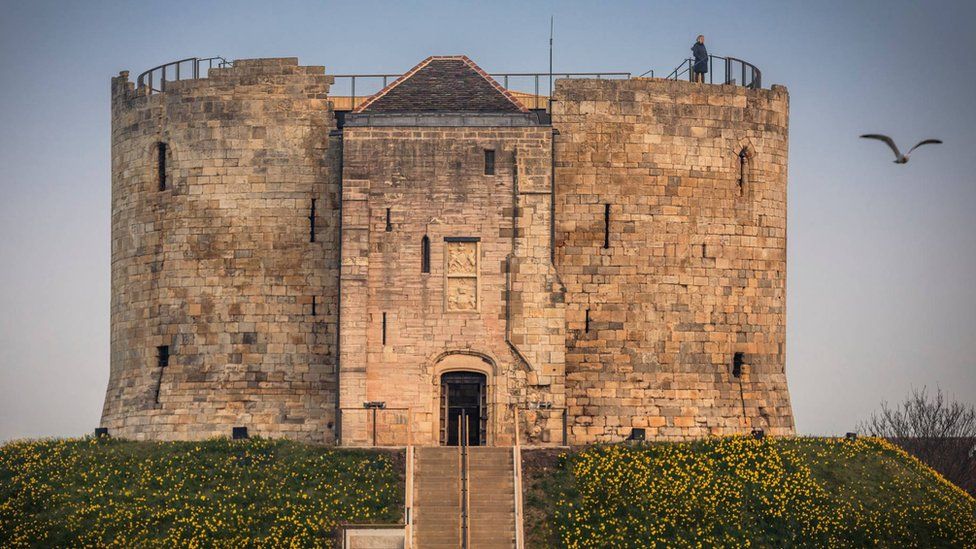York Clifford's Tower to reopen after £5m refurbishment
- Published

The tower sits on a 36 ft (11m) high mound in the middle of York
A 13th Century tower and former seat of royal power in the north of England is to reopen after a £5m revamp.
York's Clifford's Tower ruin, which sits atop a 36ft (11m) mound, is one of the city's most famous landmarks.
New walkways, stairs and a roof deck will allow visitors to see previously inaccessible parts of the structure, according to English Heritage.
The 16-month upgrade went ahead after previous plans were withdrawn amid public opposition.
A raft of conservation work was also carried out on the tower, including repairs to turret stairs, arrow slits, fireplaces and damaged stonework.
Newly-visible areas include the original royal chapel and a toilet thought to have been built for Henry III.
Workers widened the 55 steps to the tower entrance, adding new handrails and resting points added.
A free-standing timber structure, containing walkways and stairs, has been installed, leading visitors 32ft (10m) up to the roof deck.
Four wooden pillars support the new walkways, staircases and roof deck
The work means visitors can see a toilet fit for a King for the first time
Jeremy Ashbee, head properties curator at English Heritage, said the site was previously home to the first wooden tower constructed by the Normans to stamp their authority on the north of England.
He said the 800-year-old Clifford's Tower was one of the country's "most important" buildings.
"We not only wanted to preserve this incredible building but also do justice to its fascinating and multi-faceted history," he said.
Clifford's Tower
The stone tower was built in the 1250s, replacing an earlier wooden structure
It sits on top of a castle mound created by William the Conqueror in 1068
It was the site of a major attack on the city's Jewish community in 1190
The stone tower was reduced to a shell by a fire in the 1680s
It is the only remaining structure of the city's castle. Most of the buildings were destroyed in the 18th and 19th Centuries when the city's court and prison were built
The tower was surrounded by the Victorian prison until the 1920s
Source: English Heritage
Hugh Broughton, from project designers Hugh Broughton Architects, said his team had not tried to "remake the tower" and sought to minimise the impact of the new structures upon the building.
A hole in the new roof deck would allow in the elements, he said, ensuring that the tower "remains a ruin".
The new roof deck has a hole to emphasise the tower is a ruin
The roof deck provides views across the city
At the base of the mound a three-wheeled vehicle will offer tickets, information and guidebooks along with an animated display of the interior for people unable to access the site via the stairway.
Planning permission for the scheme was granted in 2020 after an earlier plan, including the construction of a new visitor centre at the base of the tower, was withdrawn due to public opposition.
Related Topics
- Published9 February 2022
- Published2 October 2019
- Published28 October 2016